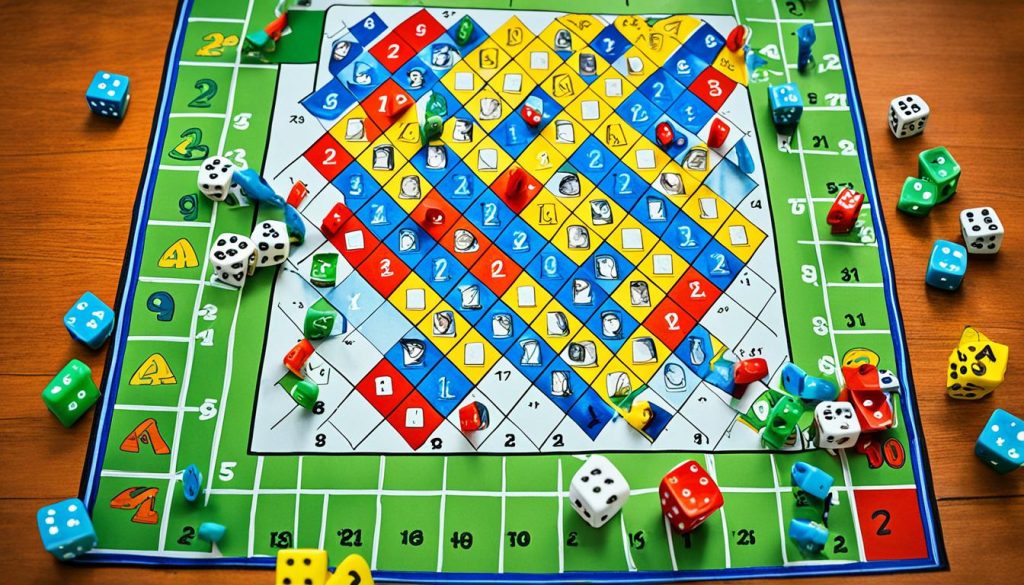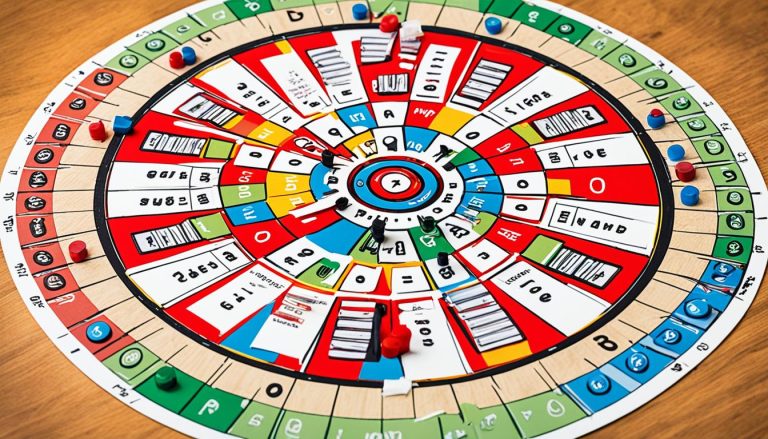Welcome to our comprehensive guide on how to play Snakes and Ladders, the popular board game that has entertained families for generations. In this game guide, we will walk you through the rules and instructions of Snakes and Ladders, providing you with all the information you need to start enjoying this classic game.
Snakes and Ladders, which originated in ancient India as “Moksha Patam,” is a game that combines luck and strategy. The objective is simple – navigate your playing piece from the starting point to the finish line, avoiding snakes and utilizing ladders to your advantage.
In Snakes and Ladders, each player takes turns rolling a die to determine the number of spaces they can move. The board is marked with numbered squares, and the players must follow the numbers as they progress towards the finish line. However, the game is not without its challenges. Snakes are scattered across the board, and if a player lands on the head of a snake, they must slide down to the tail, losing progress in the process. On the other hand, landing at the base of a ladder allows a player to climb up and skip ahead.
The first player to reach square 100 is declared the winner, but there’s a catch – they must roll the exact number required to land on the final square. It’s a game of chance and strategy, making each move exciting and unpredictable.
So, if you’re ready to embark on a thrilling journey up the ladders and down the snakes, let’s dive into the detailed rules and instructions of Snakes and Ladders. Read on to discover everything you need to know about this beloved board game.
Equipment for Snakes and Ladders
To play Snakes and Ladders, you will need a Snakes and Ladders board, a die, and playing pieces.
The Snakes and Ladders board is a numbered grid that represents the different squares of the game. It provides a visual representation of the game’s progression and helps players track their movements. Here is an example of a Snakes and Ladders board:
Next, you will need a die. The die is used to determine the number of spaces a player can move on the board. Rolling the die adds an element of chance and excitement to the game.
Finally, you will need playing pieces to represent each player on the board. The playing pieces can be any small and distinct object such as coins, bottle caps, or figurines. Each player should have a unique playing piece to easily distinguish their progress on the board.
With the Snakes and Ladders board, a die, and playing pieces, you have everything you need for an enjoyable game of Snakes and Ladders!
How to Play Snakes and Ladders?
Snakes and Ladders is a delightful board game that offers hours of entertainment for players of all ages. To begin the game, follow these simple steps:
- Each player rolls a die, and the player with the highest number goes first. This adds an element of excitement and anticipation to the game right from the start.
- Take turns moving the playing pieces from left to right, following the numbers on the board. The numbers indicate the number of spaces the player can move their piece.
- For example, if the player rolls a 4, they can move their piece four spaces ahead.
Now, let’s delve into the exciting gameplay of Snakes and Ladders!
Rolling the Die
The roll of the die determines how many spaces a player can move on the board. It adds an element of chance and unpredictability, making each turn an exciting moment. Remember, the goal is to reach square 100 before anyone else. A higher roll can give you an advantage, so hope for that lucky number!
Moving the Pieces
As you progress through the game, you’ll encounter snakes and ladders along the way. The position of these snakes and ladders can greatly impact your progress. Let’s take a closer look at how they affect the movement of your playing piece:
| Event | Effect on Piece |
|---|---|
| Landing on the top of a snake | Your piece slides down to the bottom of the snake and remains there until your next turn. |
| Landing at the base of a ladder | Your piece immediately climbs to the top of the ladder, allowing you to skip ahead several spaces. |
These snake and ladder encounters add an exciting twist to the game, allowing players to make quick progress or face unexpected setbacks.
Remember, the game continues until a player successfully reaches square 100. Keep rolling the die, moving your piece, and strategize your moves to outsmart your opponents!

Winning the Game and Bounce Back Variation
In order to win the game of Snakes and Ladders, players must strive to be the first to reach the highest space on the board, typically square 100. The key to victory lies in rolling the exact number required to land on the final square. If a player rolls a higher number, their piece will remain in its current position until their subsequent turn.
However, Snakes and Ladders also offers a thrilling twist known as the Bounce Back variation. In this variant, if a player overshoots square 100, their piece will bounce back a specific number of spaces, bringing new challenges and opportunities for each player.
For example, imagine a player finds themselves on square 96. They roll a 6, hoping to reach the much-anticipated 100. However, instead of landing on the final square, their piece moves to 100 and then bounces back to 96, followed by 95, 94, and so on. This adds an extra layer of excitement and strategic thinking to the game, as players must carefully calculate their moves to avoid overshooting square 100.
The Bounce Back variation injects an element of unpredictability and suspense, keeping players engaged as they navigate the board and roll the dice. It adds an extra dimension to the gameplay, making each move crucial and ensuring that every player has a chance to turn the tides in their favor, even when victory seems within reach.

Tactics for Winning:
While luck plays a significant role in Snakes and Ladders, players can still employ a few strategies to increase their chances of winning:
- Always aim to roll a six, as it grants an additional turn and can provide a significant advantage.
- Pay careful attention to the positions of snakes and ladders on the board. Strategically plan your moves to avoid snakes and utilize ladders to your benefit.
- Make use of the Bounce Back variation to your advantage. Consider purposely landing on certain squares to create opportunities for advancement.
By combining luck with a thoughtful approach, players can enhance their gameplay experience and increase their odds of emerging victorious in Snakes and Ladders.
| Player Tips: | Winning Probability |
|---|---|
| Rolling a six | Higher chances of advancing quickly on the board |
| Avoiding snakes | Reduces the risk of sliding back to lower squares |
| Strategically using ladders | Allows faster progress and avoids potential snakes |
| Utilizing the Bounce Back variation | Increases flexibility and provides opportunities for advancement |
Strategy Tips for Snakes and Ladders
While Snakes and Ladders is primarily a luck-based game, there are a few strategies that players can employ to improve their chances of winning.
- Roll as many sixes as possible: Rolling a six grants an extra turn, giving you more opportunities to advance on the board. Aim to roll the highest number whenever possible to maximize your chances of reaching the final square.
- Pay attention to snake and ladder positions: Take note of where the snakes and ladders are located on the board. Strategize your moves to avoid landing on the heads of snakes, which will slide you down the board, and aim to land on the bases of ladders, which will propel you forward.
- Utilize the Bounce Back variation: In the Bounce Back variation, intentionally landing on certain squares can create opportunities for advancement. By strategically positioning yourself near ladders, you can take advantage of the bounce-back mechanic to quickly climb up the board.
By implementing these snakes and ladders tips and using a combination of luck and strategy, you can enhance your gameplay and increase your chances of winning the game. Remember to stay adaptable and make the most out of each roll to outsmart your opponents and reach the top of the board.
Pros and Cons of Snakes and Ladders Strategy
| Strategy | Pros | Cons |
|---|---|---|
| Rolling as many sixes as possible | Increases the chances of additional turns | Relies heavily on luck |
| Paying attention to snake and ladder positions | Allows for strategic movements and decision-making | May require careful observation and planning |
| Utilizing the Bounce Back variation | Creates opportunities for advancement and catching up | Requires foresight and risk-taking |
Conclusion
Snakes and Ladders is a timeless board game that offers fun for players of all ages. Its simple rules and element of luck make it the perfect beginner’s guide to snakes and ladders, allowing newcomers to quickly grasp the game and start playing. However, mastering snakes and ladders goes beyond luck. Experienced players can develop strategies to increase their chances of winning, enhancing the excitement of the game.
Whether you’re a beginner or a seasoned player, snakes and ladders for beginners is a great way to spend quality time with family and friends. Gather your loved ones, set up the board, and embark on an entertaining journey. Laugh together as you climb ladders and groan when you land on a snake. Experience the thrill of reaching the final square, inch by inch, while enjoying each other’s company.
Snakes and Ladders is more than just a game. It brings people together, fosters friendly competition, and provides countless hours of entertainment. So, whether you’re in the mood for a casual game night or seeking to master snakes and ladders, this classic board game has something for everyone. Enjoy the thrill, embrace the unpredictability, and let the journey begin!






